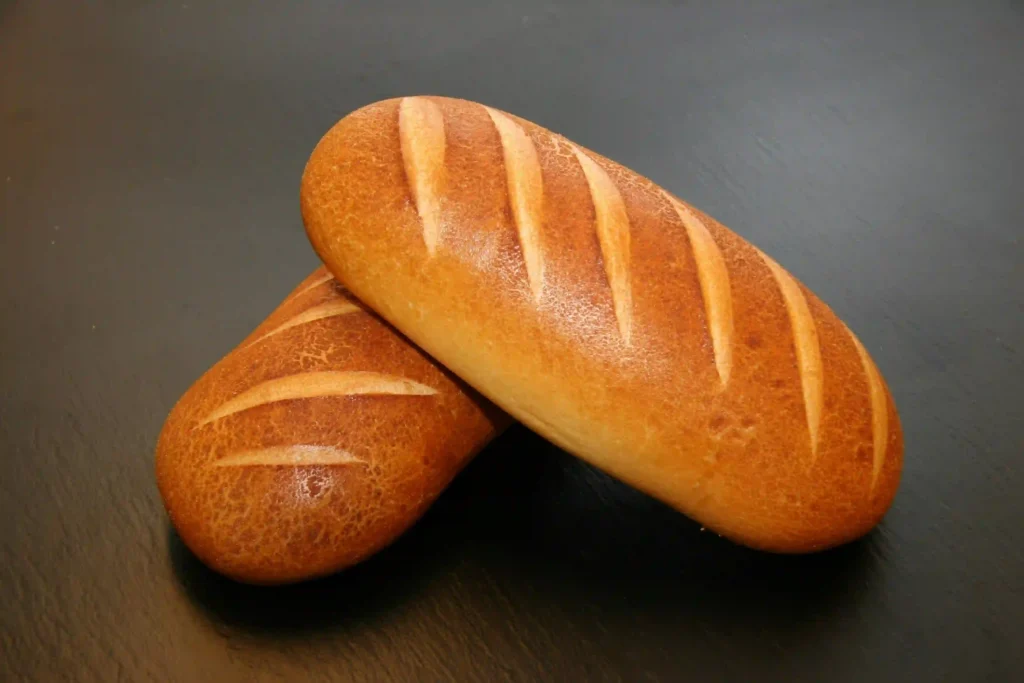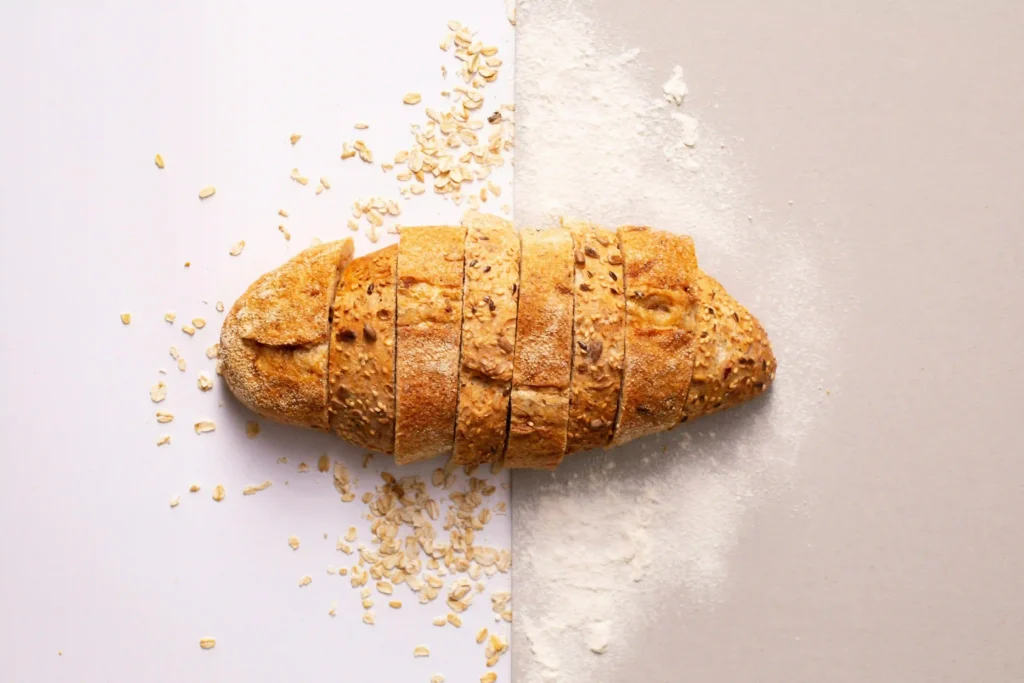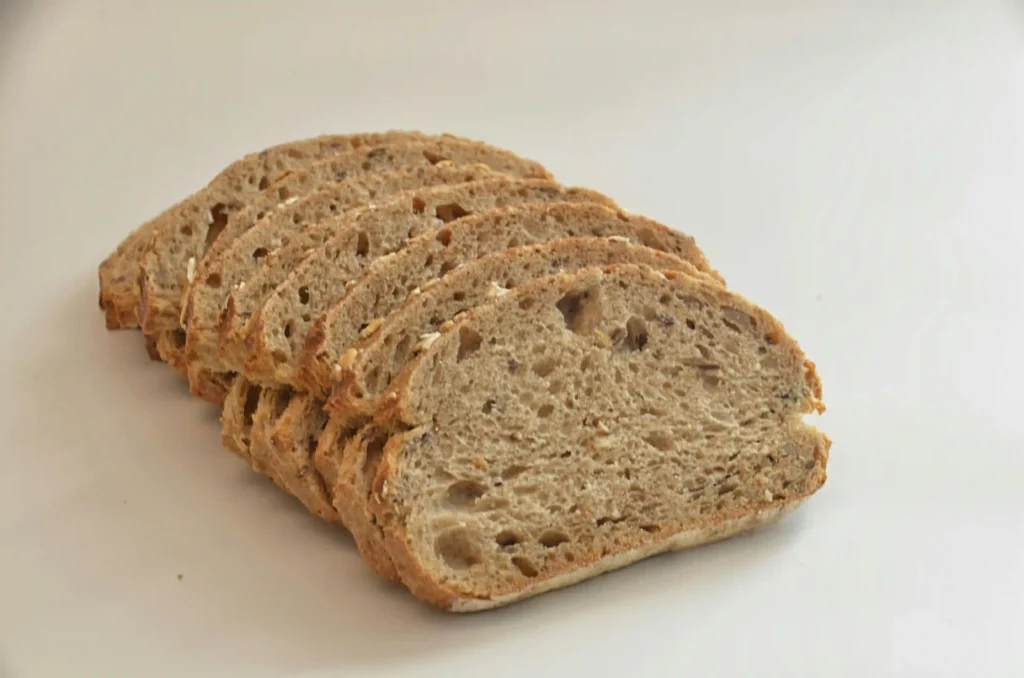Introduction

European breads are rich and varied; each bread creation contains the flavor of their country. Soft and fluffy, crisp, hefty and crusty, the soil of culture in the continent of Europe is as shaping the bread you ever desire. Every one of the breads has a history and have been produced with a lot of work. In this blog, we will se Europe 31 Tastiest Breads How Many Have You Tried?
Table of Contents
1. France: The Iconic Baguette
Baguette is not only bread; it is an emblematic product of France. This loaf is characterized with a shape of a long indention with crust outside and soft inside. It is usually eaten fresh and commonly served with just a knob of butter, or a slice of cheese. As a part of UNESCO’s intangible cultural heritage the baguette is present at French tables and markets as a symbol of simplicity and culinary art. It is almost a prerequisite to any French meal.
2. Italy: Focaccia with Herbs
Focaccia is an Italian unleavened baked good, usually unleavened, served as a flat bread olive oil and rosemary seasoned with sea salt. For many people it is a staple because it has a soft inside and a crunchy outside. Focaccia may be served as a side dish, a sandwich bread or a snack that provides that prized Italian influence of artisanal baking. Additions consist of tomatoes or olive or onions placed on top of the bread. Its scent and kind are simply aimed at enchanting the heart and soul of Italian food. You can also learn about 6 Unexpected Italian Regions Every Foodie Needs to Visit.
3. Germany: Pretzels (Brezel) – A Salty Classic
The Germans call their pretzels Brezels, a term that crops up as soon as you taste these curling strips of yeasted dough, browned and glossy, and generously dusted with salt. Biscuits: Whether soft and small like cookies that melt in your mouth, or hard and crunchy like crackers, they are popular with everyone all over America. Combining with mustard and particularly beer, pretzels are easy snacks enjoyed much at Oktoberfest and even at other occasions – bread baking is deep in German roots. Because of their relatively tough consistency, they’re equally enjoyable throughout the day.
4. Spain: Pan con Tomate – A Rustic Delight
Pan con Tomate is a famous Spanish dish which actually roasts the bread coupled with tomato. This is bread toasted and when served, is sprinkle garlic and olive oil and a grated tomato is placed on top of the bread. A Fruit of the Mediterranean Spanish Gazpacho is a regular serving on the breakfast table as well as tapas bars and restaurants. And it is a good example of how Spain people have developed their cuisine.
5. Portugal: Pão de Deus – Bread of God
Pão de Deus or translated as “Bread of God’ is a small soft and tender bread baked and rolled in a coconut icing. It is mostly consumed as breakfast or means between meals, can be accompanied by butter or jam. This bread is a symbol of traditional Portuguese pastry production, baked for special and not so special occasions. In taste it is sweeter than most European breads, at least the ones that I have tasted.
6. Greece: Pita – A Mediterranean Staple
Pita bread is a staple for Greek cuisine and can be used in many various ways. These small, tender rounds are ideal for serving dips – like tzatziki or as pocket bread for souvlaki or gyros. Incredibly soft and slightly dense, with mild and almost bland taste, pita offsets exactly the unpretentiousness and functionality of the Mediterranean cuisine. It is a staple to many things in Greek cuisine .
7. Ireland: Soda Bread – A Quick and Simple Loaf
It is an Irish specialty, relatively simple in terms of its recipe – soda, flour, and buttermilk. It has a soft grainy feeling that with a little sour twang that is so suitable for heavy meals. Traditionally made with plain flour, soda bread is frequently stirred with raisins or seeds and has always been an example of the Irish learning how to produce fulfilling meals with what was available at hand. It is warm and rustic, and lovely to drink on cold winter’s day.
8. Denmark: Rugbrød – A Healthy Rye Bread
Rugbrød is Denmark’s favorite rye that has a heavy and wholesome texture in the mouth. It’s dense, nutritious and full of fiber – an essential part of the traditional Danish smørrebrød. Served with everything from herring to avocado, rugbrød is a healthy dish of the Nordic region. It just provides nutrition as well as satisfies the taste buds perfectly.
9. Sweden: Knäckebröd – Crisp and Nutritious
Knäckebröd are crispbread that has origin from Sweden; it is not just a snack but it is dinner too. It is made from rye flour and toasted to crispiness – these breads are also low in fat and high in fiber compared to the norm. Best eaten with butter, cheese or smoked salmon, Knäckebröd is a popular product in Sweden. Due to its satisfying crunch, it is a preferred snack to using it for snacking while promoting the healthy lifestyle.
10. Austria: Kaisersemmel – The Imperial Roll
The Kaisersemmel, an imperial roll of Austria, has a unique shape, a star at the top. Described by its cripsy layer outside and soft inside, It is a meal that is eaten with soups and sausages among others. This roll is one of the many examples of Austria’s great legacy in baking that people enjoy at the moment. Its design truly reflects the vibes of Austria in terms of the layout.
11. Poland: Obwarzanek – A Precursor to Bagels
The obwarzanek is a Polish bread and can be described as one half bagel one half bread in terms of texture and crunch, this bread has a glossy surface. Usually we add sesame, poppy seeds or salt on them, they are can be bought on almost every street in Poland, specially in Kraków. Originally the dough is boiled, which provides it with the proper texture. Served and consumed devoid of any additions, or garnished in a variety of ways, Obwarzanek is a polish snack synonymous with polish tradition. It is especially important in history and incredibly tasty, which makes it well worth it for anyone interested in great breads.
12. Hungary: Pogácsa – Savory Biscuits

Pogácsa is a small biscuit food very popular in the Hungary household. Prepared from wheat flour and pig fat and sometimes with cheese or pork cracklings, they can be served alongside soup or, on their own, as a snack. These perfectly golden crusty pastries is an exemplar of Hungary penchant for well flavored breads and pastries. Even merely with each bite one can feel how fulfilling it is, making Pogácsa ideal snack for celebration or party.
13. Czech Republic: Veka – Versatile Bread for Open Sandwiches
Veka is the soft, elongated bread product originally from the Czech Republic who’s identity has been morphed to fit a seemingly never ending list of versatile uses. Sometimes cut into thin rounds, it is exceptionally suitable for representing the meal known as chlebíčky, which is traditional of Czech Republic. This processed cassava product is almost tasteless, light and fluffy in texture, which can well absorb any toppings, from meat to vegetables. That is a perfect example how a bread can turn into blank slate in terms of culinary.
14. Norway: Lefse – A Potato-Based Flatbread
Lefse is traditionally Norwegian, potato based flat bread combined with flour and butter. Cook it on a griddle, and they are soft and easily foldable, used for rolling purposes. For its toppings, Lefse can be rolled with butter, sugar or delicious fillings then it became a center piece of Norway’s creative cooking. Norwegians love this bread as it remains an important cultural cake even though it has been classified under the simple cakes.
15. Finland: Ruisleipä – Traditional Rye Bread
Ruisleipä, essentially a rye bread from Finland, is quite heavy, slightly sour and full of fiber and whole food goodness. Whole rye flour and a sourdough starter – a common product in all Finnish households. Best served as a side to butter, cheese or smoked fish this bread is perfect for any meal during the day. The dense and intensely flavored ruisleipä stands for Finland’s core characteristics concerning essential cooking and eating traditions.
16. Switzerland: Zopf – A Braided Beauty
Zopf is a Swiss bread which may be braided; it has a tender crumb and a shiny yellow surface. This small bread is leavened with milk, butter, and yeast, and have a slightly sweet taste, it is usually taken on Sundays. Its braid design looks complex; therefore, people use it particularly during celebrations and its taste best goes with jams or cheeses. Zopf is a perfect representation of how artisans bake their bread in Switzerland.
17. Belgium: Cougnou – Sweet Bread for the Holidays
Cougnou as known as the “bread of Jesus” is a Belgium sweet bread that is majorly prepared during Christmas. It is shaped like wrapped up baby and is sweetened with sugar and raisins and may be finished off with pearl sugar. It is a tradition people of all ages enjoy throughout the holiday season, which makes it also known as festive bread. Cougnou, with its outstanding shape and taste, has become one of the main attributes of holidays.
18. Netherlands: Ontbijtkoek – A Spiced Breakfast Bread
Ontbijtkoek is a Dutch breakfast cake or bread, spiced usually consumed with butter, best served in slices. This is produced from rye flour and spices such as cinnamon, cloves and ginger; it’s more ‘sponge-like’. Best to be eaten as snack, breakfast food, accompanied with a piece of cheese, butter or a cup of tea or coffee, Ontbijtkoek is truly filling. It has warm sweet characteristics and is also particularly popular during Breakfast among the Dutch.
19. Scotland: Bannocks – Rustic Oat Bread
Pronounced ‘banuca’, Bannocks are Scottish unleavened oat cakes that are grilled. Sturdy and packed they usually are served with butter, cheese or jam. These represent Scotland’s fondness for equalization of original and unembellished components and are favorites at the highland bash. This even lamb creates a rustic taste and texture that fits well in any time of the day.
20. England: Crumpets – Perfect for Tea Time
Today crumpets are considered to be an English tea-time cake with porous structure and peculiar circular holes. This is made with a rather basic of flour, water and yeast and then toasted and eaten with spread or jam. Due to their porous structure, crumpets hold all the toppings in well and each mouthful is wicked naughty. They are fashionable and still a familiar part of British cooking.
21. Wales: Bara Brith – A Fruity Loaf
Bara Brith, a speckled bread, is a type of Welsh fruit loaf which is tinged with tea and spices. It is loaded with dried fruits and eaten mostly in Wales with butter at Welsh tea tables. Widely known because of its sweet, moist, spicy taste and because of the fragrant spices, it is indeed a delicious snack. Bara Brith is one of the examples of exquisite baking heritage of Wales.
22. Turkey: Simit – The Turkish Bagel

Simit is a sweet or savoury bread ring that is known as the Turkish bagel. This cylindrical bread product is crisp on the outside, with a thick layer of sesame seeds and soft on the inside. Unlike with bagels, simit is not boiled before baking thus making it lighter, when compared to bagels. They usually take it in the morning, during a break or instead of lunch together with tea, cheese or jam. This makes it possible to note why Simit is such an essential element of the everyday life of every Turkish city, as can be seen in the figure below, which features Simit vendors all around the cities.
23. Russia: Borodinsky Bread – A Flavorful Rye Loaf
Borodinsky bread is a typical Russian dark bread not only distinguished by its slightly sour and nutty taste enriched by a characteristic moist texture. Use of coriander and caraway seeds gives a dish a truly fabulous and unforgettable flavor. Once molasses or malt extract is added it gives a mild sweet flavor to offset the normally tangy texture of the bread. Similar to many Russian bread recipes Borodinsky bread accompanies butter, cheese or cured meat and is one of the examples of Russian baking culture.
24. Croatia: Lepinja – Soft and Fluffy Flatbread
Lepinja is as a flat bread which is tender and light with a slightly elastic crust. Most often they are eaten with grilled meats like ćevapi, or used as a base for sandwiches. Commonly, yeast dough contains flour, water, yeast and a little sugar – that is why the crumb is so airy. It is a staple part of Croatian and other Balkan dishes by virtue of its fantastic mouth feel and its practical usage in every meal.
25. Serbia: Proja – Cornbread with a Twist
Proja is a basic Serbian cornbread or near-bread made from cornmeal, water, and salt – a wonderful starting point for getting a taste for Serbia. Derived from cornmeal, water, oil and sometimes cheese it is a food preferred by many people, especially those in Serbia. Unlike some American cornbread that is soft, closer in texture to a cake, Proja is more compact and less sweet; it is usually prepared in a rectangular baking dish and then sliced into squares. Corn flour is often eaten as a side dish or snack and garnishes many food products, as it has a thick throaty mass and pleasing corn taste.
26. Bulgaria: Pogacha – Bread for Celebrations
Pogacha is a type of round, soft bread that is used in so many Bulgarian ceremonies and festivities. This European bread is made from white flour, yogurt, eggs, and has wonderful texture, pale crumb, crisp crust. It is usually marked out with elaborate patterns before it is baked a symbol of wealth or prosperous times. Purposely, Pogacha does not need the tools for preparation and is divided by hands and Being shared among the family and guests it represents the idea of hospitality and unity among the Bulgarian people.
27. Romania: Cozonac – A Sweet Holiday Treat
Cozonac is a sweet bread similar to a cake, customary for Romanian holidays, such Christmas and Easter. Made using milk, butter and eggs, the dough for these honey spoons could be loaded with a variety of things like walnuts, cocoa or even Turkish delight. Filled in round shape and baked until a glorious brown, the loaf is sliced to show its beautiful spiral patterns and colored layers. This sweet delicacy signifies happiness and prosperity due to it’s inclusion during celebrations in Romania.
28. Ukraine: Paska – Easter Bread with Symbolism
Paska is a traditional Ukrainian Easter bread that not only looks great and yummy but has big symbolic meaning as well. It is a pastry made from flour, eggs, butter and sugar and the decoration is almost always religious, here resembling dough toys. That is commonly made in high, cylindrical tins, and has a fine, close, light texture when it is properly baked. Paska is taken to Church during Easter and everyone brings home a portion to signify new live in the Ukrainian tradition.
29. Estonia: Karask – A Unique Barley Bread
Karask is a type of quick bread that originating from Estonia and it is prepared from compound of barley or rye floor accompanied with buttermilk or yogurt. This is a heavy bread made with a moderately sweet, slightly tangy dough which can contain other ingredients such carrot or raisins. Conventional in its preparation, Karask is an unleavened bread, which serves well to attest to the Estonian country heating cuisine. It is usually taken fresh, often accompanied by butter, or different type of cheese.
30. Latvia: Rupjmaize – Dark Rye with Tradition
Rupjmaize is peculiar type of the Latvian black rye bread for which it separates with its thick and strong taste. Operated from coarse rye flour and using natural collecting agents, it containerizes a touch weary taste. The Rupjmaize is typically flavored with malt or molasses; the former makes it quite dark and aromatic. In Latvia, it is common to accompany it with butter, cheese or smoked fish – all rearing back to the country’s agricultural roots.
31. Lithuania: Šakotis – Bread Meets Cake
Šakotis, which means ‘branched tree’ is a Lithuanian cake most popular during weddings and all other festivities. Clumsily prepared from eggs, butter, flour and sugar, popularly known as crepes Suzette, it is grilled on a circular grill over a fire. From it flows a sticky dough that resembles tree branches; this makes Šakotis unique. This labour productively candy signifies richness and is a standout among the most conventional desserts at Lithuanian festivities, demonstrating the nation’s baking aptitudes.
Conclusion:
The breads of the Europe are as diverse as the cultures explored throughout the continent from the civilized to the crude. Beginning with the humble Irish Soda Bread and moving up to one of the more complex Lithuanian Šakotis, each represents the taste and belief of its culture. It is therefore not fun or just a simple delight for the taste buds to discover all the 31 traditional breads; it is equally learning the history of Europe’s heart. No matter if consumed hot from the oven or with a cup of tea as part of a Filipino meal, it makes me recall everyone’s basic happiness that comes from baking. So, how many have you tried?